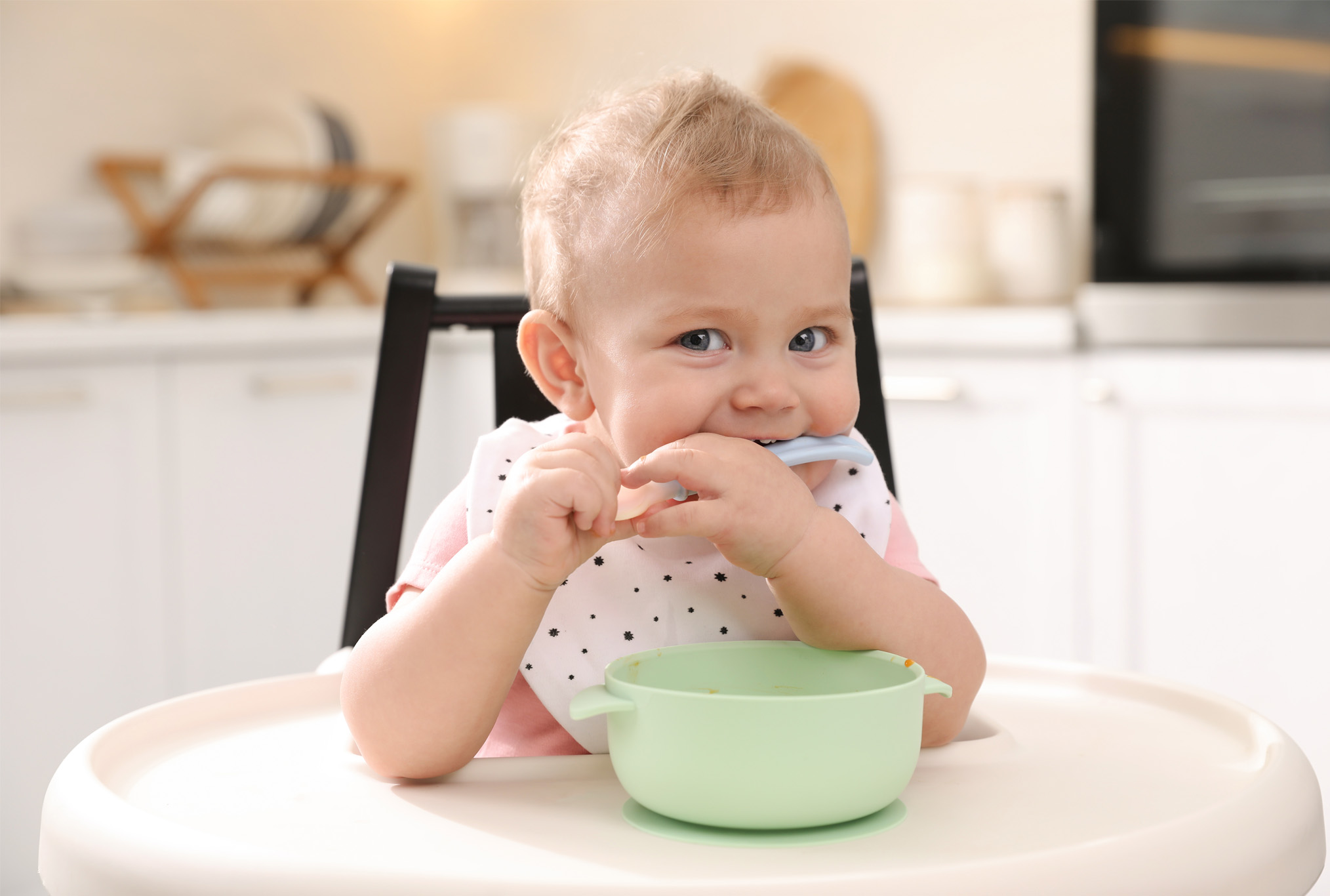Stage 2 Baby Foods
Reading time:
Reading time:

By Nicole Lattanzio, RDN, CSP, IBCLC
Introducing solids into your baby’s diet is a key milestone in their growth and development. This starts the transition from a diet solely of breastmilk and/or formula to one that incorporates a wide range of foods.
The introduction of complementary foods begins around 6 months of age with the goals of meeting the baby’s changing nutrient needs as well as supporting the development of chewing and swallowing skills. However, it’s important to note that the “right” time to start solids can vary a bit from one baby to another! Ensuring your baby is both interested in food and developmentally ready to start is key to an enjoyable experience.
As a caregiver, you may be feeling a mix of excitement and anxiety in preparing to start solids with your baby. In this guide, you’ll learn how taking a gradual approach to introducing foods to your baby can help ease these emotions and ensure a smooth transition.
Many parents start preparing for solids by exploring the baby food aisle at the store. This can be an overwhelming experience! Shelves are stocked with so many options and vary in number of ingredients, type of food, organic vs conventional, and more. One of the most confusing options for families can be which “stage” to start with.
These baby food stages on labels can guide you in where to start and how to advance. While the age recommendations behind stages can vary slightly, check out this general breakdown of what these stages mean:
Stage 1 (4+ months): Single-ingredient, watery thin purees for spoon-feeding.
Note: While these may be labelled for 4+ months, you should always discuss your 4-month-old’s readiness for solids with your paediatrician before starting. Most 4-month-old infants are not developmentally ready for sitting and eating foods.
Stage 2 (6+ months): Single- or multi-ingredient, strained or mashed for spoon-feeding.
Stage 3 (9+ months): Multi-ingredient mush that has soft, chewable chunks.
Stage 4 (12+ months, AKA “toddler” food): Wider range of ingredients and highly textured pouches or ready-made meals.
While you can start with stage 1 with your 6-month-old baby, many babies can also start with stage 2 baby foods! Stage 1 is not a requirement for babies who are developmentally ready (i.e. sitting, showing interest in food, good head/neck control, etc.) to start solids.
Stage 2 baby foods have a thicker texture than stage 1 as stage 2 blends are mashed or strained. These foods are easier to spoon-feed your baby as they stay on the spoon more easily. With this thicker texture, you can also preload spoons to allow the baby to self-feed. In comparison to stage 1 watery purees, the thicker texture of stage 2 baby foods helps babies continue building their oral skills by moving food from the front to the back of their mouth.
Stage 2 baby foods may be single-ingredient or contain multiple ingredients. Ingredients may include fruits, vegetables, meats/legumes, and/or grains. You may even find blends that include herbs and spices! Offering a variety of each food group over a week provides babies with a wide range of essential nutrients for growth.
This variety makes stage 2 baby foods exciting for your baby! Baby foods with more than 1 ingredient provide a range of unique flavour profiles and help build a baby’s palate.
While babies may be ecstatic to start eating “grown-up foods,” there is a lot of learning and developing that takes place to get there!
Reflexes dictate when babies are ready for food as they transition from milk-only to complementary foods. Babies are born with rooting and suck-swallow reflexes that allow them to drink their milk via breast or bottle. The suck-swallow reflex diminishes around 3-4 months of age when sucking then becomes voluntary. Additionally, babies are born with protective reflexes including tongue thrust and gagging to avoid choking. Tongue-thrust reflex begins to diminish around 4-6 months of age whereas gagging reduces around 6-9 months. Combined, babies are more developmentally ready to consume foods closer to 6 months of age. Premature introduction of foods can be challenging as the baby spits more food out (tongue-thrust reflex), sucks on the spoon (sucking reflex), or gags with foods entering their mouth (gagging reflex).
Staged baby foods are crafted with the baby’s shifting reflexes in mind. As we’ve mentioned, stage 1 baby foods are very watery and are appropriate for infants who have recently moved towards a voluntary suck and are beginning to become less sensitive to gagging. Stage 2 baby foods have a bit more texture so babies who are readily accepting food into their mouths (AKA have a diminishing tongue-thrust reflex) do well with this texture and gain skill in manoeuvring food in their mouth from front to back for swallowing.
As we advance to stage 3 foods which include chunks of food, babies learn a new skill – chewing! The action of chewing is voluntary and requires the baby to learn this new motor pattern. The final advancement to stage 4 (toddler) foods includes everyday foods and textures that are generally prepared a bit softer than big kids and adults may eat. At this point, your baby is skilled at chewing and can eat a wide range of foods – including family meals! – if not already regularly incorporated.
While babies build their oral motor skills, they are simultaneously building their palate! It is incredibly important to provide your baby with a wide range of foods and textures over time to encourage exploration and promote enjoyment around mealtime.
As you’ve learned, starting solids is important for a variety of reasons from nutrition to development. You’ll quickly see how your baby progresses with food and builds their list of accepted foods.
A wide range of foods can be offered to your baby from the beginning. Options offered will largely be determined by the foods available in your area and whether you choose to purchase baby foods, make your own, or provide a combination. The list below includes appropriate options for your 6- to 8-month-old baby with safety considerations:
Fruits: apple, pear, peach, plum, nectarine, blueberries, raspberries, blackberries, strawberries, banana, mango, kiwi, oranges, pineapple.
Vegetables: asparagus, green beans, bell peppers, broccoli, pumpkin, potatoes, squash, beets, carrots, leafy greens, tomato, sweetcorn.
Grains: oats, rice, quinoa, pasta, whole grain breads, millet, barley, farro.
Proteins: turkey, chicken, beef, tofu, salmon, eggs, lentils, beans, plain yogurt, cottage cheese, peanut/nut/seeds.
Healthy fats: avocado, oils (olive, coconut), butter, ground flaxseed, chia seed.
Flavour additives: basil, garlic, ginger, cumin, cinnamon, paprika, chili powder, coriander, turmeric, mint, rosemary.
There are so many options to feed your baby! The most important thing is to offer your baby a variety of foods that are accessible to you in ways and amounts that are developmentally appropriate for them. There is not a specific number of foods you need to have offered at any point in time.
Babies don’t need to dive right into 3 meals per day. Gradual advancement is best to allow their digestive systems to adjust to food, preserve milk feeds, and ease into the baby’s routine.
Meals by age:
6 months = 1 meal
7 months = 1-2 meals
8 months = 2 meals
If your baby seems to want more meals than the above, they may need adjustments in their routine. Babies 6-8 months of age do not need additional solid food times such as a scheduled snack time – milk feeds take the remaining feedings! Snack foods (i.e. puffs, meltables) can be offered as part of the meal if desired, however. Ensuring baby are getting enough milk feedings, eating foods with protein and fat in their solid meals, and getting enough food at their meals to satisfy their appetite are key. More insight on how breastfeeding and solids can work together here.
When starting solids, a common question is “How much is the proper portion to feed?”. The “right” amount of food is the amount your baby wants. Babies often progress from eating just a spoonful or two to a whole jar. There is also variability in how much they’ll want to eat on any given day – and that translates into childhood! You’ll know how much food your baby needs by watching and listening to their cues.
“More Food!” Cues “All Done!” Cues
✓ Opening mouth for more X Pursing lips closed or turning away
✓ Actively watching food X Looking away or distracted
✓ Leaning in for bites X Losing interest in eating
The number of meals increases from 6- to 8-month-old babies and other changes include improved oral motor skills and increased interest in eating. These make mealtimes more enjoyable all around and open doors to more options.
Breakfast: applesauce mixed with baby oatmeal.
Breakfast: stage 2 bananas sprinkled with ground flaxseed, plain yoghurt with cinnamon.
Dinner: blended vegetable lentil soup, Little Bellies Organic Pick-Me Sticks.
Feeding routines will evolve as your baby gets older, eats more food at meals, decreases milk feeds, drops a nap, and has changes to life routine in general. Around 10 months of age, your baby will be ready for a snack in their routine.
However, snack foods can be offered as a complement to meals while the baby is younger and eating stage 2 meals. Baby snack foods designed to help babies 6-8-months-old build their oral motor skills are great options to offer with meals. Snacks such as Little Bellies TASTY TEXTURES promote self-feeding while quickly dissolving to a safe texture (stage 2 baby food) in the mouth. These snacks can assist with the transition from spoon-feeding to self-feeding. If your baby is sitting independently and accepting stage 2 baby foods (or higher) well, introducing these snack foods with their meal is appropriate.
While food allergies can present at any point in time, they do commonly occur after the introduction of some foods in infancy.
Please note: food allergies and sensitivities/intolerances are not the same.
Food allergies are caused by an immune system’s response to a food protein. They can occur within minutes to a couple of hours after eating a food. Symptoms may include hives, rash, swelling of lips or tongue, itching, breathing changes, or severe vomiting/diarrhea. Food allergies can be life-threatening and progress to something called anaphylaxis. If your baby shows any symptoms of food allergy, seek medical attention immediately. Foods that have caused an allergic reaction must be strictly avoided unless otherwise recommended by an allergist.
Food intolerances or sensitivities are more benign. They are not caused by the immune system and therefore are generally not an emergency. Symptoms of intolerances or sensitivities are commonly gastrointestinal and milder in nature including bloating, diarrhea, abdominal pain, or indigestion. They may be caused by components of food such as protein (ex. gluten), lactose, or food additives. Work with the paediatrician to identify which food/ingredient is the culprit to avoid unnecessary diet restrictions.
Many babies experience mild tummy troubles when starting foods that are not caused by allergies or intolerances. Digestive adjustments will happen as babies eat new foods and their tummies learn to digest and process new foods. The majority of the time, these troubles are short-lived and improve in a matter of days to weeks.
Stage 2 baby foods offer numerous benefits for your new little eater. The range of options and opportunities in the stage 2 category makes eating fun and exciting for your little one. By offering a range of foods and following their cues and readiness for advancing, you as a caregiver will instil a positive relationship with mealtime from the beginning.

Let’s Make It Official
Get the latest news on parenting tips, food play hacks, promotions and giveaways!
Subscribe Now